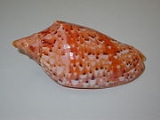
Cymbiolacca
Encyclopedia
Cymbiolacca is a small taxonomic genus
of medium-sized predatory marine
gastropod mollusc in the family Volutidae
, the volutes. This genus is often treated as a subgenus of Cymbiola
Swainson, 1831.
, Queensland
Australia, and on reefs in the Coral Sea
. They live in coral sand substrates on intertidal reef platforms to depths of over 100 m. Populations or colonies of Cymbiolacca are usually narrowly endemic.
, a solid glossy shell with a spiny shoulder (sometimes reduced) and an elongate aperture with 4 distinct columellar plicae. The colour pattern of Cymbiolacca is polymorphic, the base colour is white and it is usually overlaid with axial lines, dashes or dots and a pink, orange, red or brown tented pattern.
The largest species (reaching 140 mm in length) are Cymbiolacca thatcheri from reeftops in the Coral Sea and a population of Cymbiolacca intruderi from deep water outside the Great Barrier Reef north east of Townsville. The most widespread and polymorphic species is Cymbiolacca pulchra from the Great Barrier Reef
.
Cymbiolacca have internal fertilization and lay eggs from which snail develop directly. There is no pelagic stage. This has resulted in a wide variety of forms, each endemic to a particular population.
Genus
In biology, a genus is a low-level taxonomic rank used in the biological classification of living and fossil organisms, which is an example of definition by genus and differentia...
of medium-sized predatory marine
Marine (ocean)
Marine is an umbrella term. As an adjective it is usually applicable to things relating to the sea or ocean, such as marine biology, marine ecology and marine geology...
gastropod mollusc in the family Volutidae
Volutidae
Volutidae, common name volutes, are a taxonomic family of predatory sea snails that range in size from 9 mm to over 500 mm, marine gastropod mollusks...
, the volutes. This genus is often treated as a subgenus of Cymbiola
Cymbiola
Cymbiola is a genus of large predatory sea snail, a marine gastropod mollusk in the family Volutidae, the volutes. Some of the species within this genus are sometimes placed in the genus Cymbiolacca Iredale, 1929, which is also sometimes treated as a subgenus of Cymbiola.-Species:Species and...
Swainson, 1831.
Distribution
Cymbiolacca species live in colonies on and near the Great Barrier ReefGreat Barrier Reef
The Great Barrier Reef is the world'slargest reef system composed of over 2,900 individual reefs and 900 islands stretching for over 2,600 kilometres over an area of approximately...
, Queensland
Queensland
Queensland is a state of Australia, occupying the north-eastern section of the mainland continent. It is bordered by the Northern Territory, South Australia and New South Wales to the west, south-west and south respectively. To the east, Queensland is bordered by the Coral Sea and Pacific Ocean...
Australia, and on reefs in the Coral Sea
Coral Sea
The Coral Sea is a marginal sea off the northeast coast of Australia. It is bounded in the west by the east coast of Queensland, thereby including the Great Barrier Reef, in the east by Vanuatu and by New Caledonia, and in the north approximately by the southern extremity of the Solomon Islands...
. They live in coral sand substrates on intertidal reef platforms to depths of over 100 m. Populations or colonies of Cymbiolacca are usually narrowly endemic.
Shell description
The shells of Cymbiolacca have a small conical (usually ribbed) protoconchProtoconch
A protoconch is an embryonic or larval shell of some classes of molluscs, e.g., the initial chamber of an ammonite or the larval shell of a gastropod...
, a solid glossy shell with a spiny shoulder (sometimes reduced) and an elongate aperture with 4 distinct columellar plicae. The colour pattern of Cymbiolacca is polymorphic, the base colour is white and it is usually overlaid with axial lines, dashes or dots and a pink, orange, red or brown tented pattern.
The largest species (reaching 140 mm in length) are Cymbiolacca thatcheri from reeftops in the Coral Sea and a population of Cymbiolacca intruderi from deep water outside the Great Barrier Reef north east of Townsville. The most widespread and polymorphic species is Cymbiolacca pulchra from the Great Barrier Reef
Great Barrier Reef
The Great Barrier Reef is the world'slargest reef system composed of over 2,900 individual reefs and 900 islands stretching for over 2,600 kilometres over an area of approximately...
.
Biology
Cymbiolacca are mostly nocturnal and predate on other gastropods. During the day they remain buried in coral sand. At night the emerge and crawl on top of the sand searching for prey. They envelop prey with their colourful foot and bury in the sand to consume it. Like other VolutidaeVolutidae
Volutidae, common name volutes, are a taxonomic family of predatory sea snails that range in size from 9 mm to over 500 mm, marine gastropod mollusks...
Cymbiolacca have internal fertilization and lay eggs from which snail develop directly. There is no pelagic stage. This has resulted in a wide variety of forms, each endemic to a particular population.

